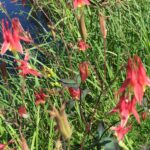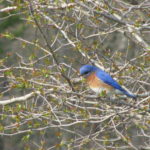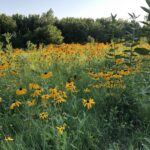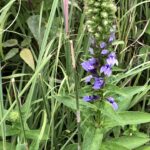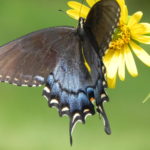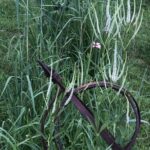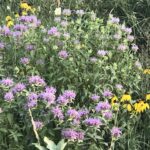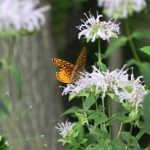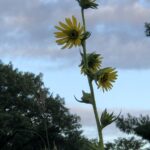What’s to Love About a Prairie?
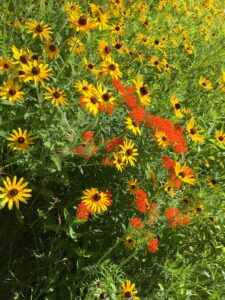
prairie forbs help pollinators
We love prairie. Prairie is color. Flowers yellow, red, blue, and every hue in between shine through tall grasses. Prairie beckons flying flowers……butterflies as well as birds, bunnies, and other interesting animals. Compared to a groomed July lawn, prairies are a joy to our eyes as grasses and flowers wave in the evening breeze.
When we moved to Winding Pathways in 2010, we inherited lawn. Lots of lawn. Starting almost immediately we transformed two big sections into a prairie. But we still had lots of lawn left. So, in late 2019 we decided to whittle it down by about another 3,000 square feet. In-place would be a short profile prairie sporting at least 70 species of wildflowers.
Lawns Have Their Purpose
We’re not anti-lawn. They are great places to relax with friends and play. There’s just too much lawn in America and its environmental impact is huge. Lawn watering annually consumes 3 trillion gallons of irrigation water, 200 million gallons of gas for mowing, and 70 million pounds of pesticides. There’s no need for that.
Ways to Ecologically Manage Lawns
- Allow diverse plants to grow.
- Avoid watering or spraying.
- Mow on a high setting. We use a battery-powered EGO mower that’s recharged by our solar electric panels.
There are lots of ways to establish a prairie. None is perfect. Some yield fairly quick results, while other methods require patience. Through a series of blogs this year we will detail how we decided to plant prairie, explain its benefits, and detail a way to achieve fairly fast results. Ours is just a model of one way to do it. We encourage anyone who has a lawn to consider transforming it into prairie or other native vegetation even if it’s only a few square feet.
Why We Are Doing It: Decision…
There are lots of reasons for converting a lawn to a prairie. Here are a few of ours:
- We’re individualists. We find neighborhoods with rows of perfectly clipped, fertilized, and sprayed lawns boring.
- We thrive on diversity. Every new bird, plant, and animal discovered in our yard is a thrill. Ecologists who have long said that diversity implies stability, are correct. Species change from year to year but always there’s change within the stability of a healthy habitat – our prairie.
- We consider mowing a waste of time and resources. Nationally, lawn mowing consumes millions of gallons of gas. Mowers spew out emissions that foul the air and contribute to climate change. Mowing is time-consuming.
- With a few exceptions, we shun chemicals. We’ve never used any insecticides and only use a few herbicides to help our prairie compete with persistent introduced plants.
- It’s all about beauty. As we sit on our summer porch colors dance in the wind from hundreds of blooming plants and butterflies hopscotch about. Prairie is a joy to the eye.
- Water is precious. Perhaps the world’s most precious resource is clean water. Deep-rooted prairie, unlike lawns, never needs irrigation. Instead, it filters, cleanses, and sequesters rain that percolates down to the water table through zillions of interlocking roots.
- Years ago, we restored one prairie. But on the other side of the drive is a swath of lawn that continually needed mowing. Worse yet, it was on a slope, causing our creaking knees to work extra hard pushing the mower upslope. So, in late 2019 we decided to convert part of it to a prairie, leaving a margin of a mowed lawn around it.
…and Early Preparation
So, we began to plan our newest prairie. Unlike the existing ones we wanted it to establish as quickly as possible and we wanted great plant diversity and lots of color with only one exception. We wanted a short-grass/forb prairie, so chose the seeds carefully. We chose not to include Big Bluestem, Switch, and Indian Grasses in our mix.
We also had to determine these things:
- Was it legal in our area? Yup. We checked ordinances.
- Would it bother the neighbors? No. We informed them and learned they were fine with it.
- Did we have the time and money to establish and maintain it? Yup. We are frugal and energetic enough to maintain and nourish the prairie.
Just What Is Prairie?
Native prairie is an enormously complex and beautiful grassland that became established in the American middle after the glaciers receded and the climate warmed and dried. It stretched from Ohio to the Rocky Mountains. Eastern prairies lived where rainfall and humidity were fairly high. It was nearly plowed to extinction and was replaced by vast corn and soybean fields. Shortgrass prairie can be just ankle high and lives in the dry Great Plains with the mid-grass prairie in between. We live in the area once occupied by tallgrass prairie, a truly endangered ecosystem. Establishing prairie is appropriate in areas that were once prairie and it is ecologically wonderful to replace lawns with vegetation native to the site.
Winding Pathways is partnering the project with the Monarch Research Project, Linn County Roadsides, Sustainable Landscape Solutions, and Pheasants Forever.
Now on to the next phases of our Prairie Renaissance. (For earlier background on pollinator patches read our blog of February 20, 2020.)
- Columbine blooms early in the season
- Bluebirds hang out on branches.
- Blackeyed Susans populate a prairie.
- Blue lobelia is one of the more demure forbs that attract pollinators.
- Black Swallowtail butterfly on cup plant.
- Culver’s Root sends up white candles of blooms.
- High summer flowers like monarda and yellow coneflower attract butterflies
- Summer is the time to attract and enjoy butterflies.
- Compass plant is among the late summer forbs.

